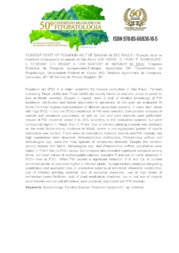Current state of fusarium wilt of banana in São Paulo.
Current state of fusarium wilt of banana in São Paulo.
Autoria: VIEIRA, H. B.; HECK, D. W.; RODRIGUES, F.; TEIXEIRA, L. A. J.; ROSSI, C. E.; SANTOS, A. dos; MORAES, W.; RODRIGUEZ, M. A. D.
Resumo: Fusarium wilt (FW) is a major constraint for banana production in São Paulo. Farmers cultivating 'Maçã' (AAB) and ?Prata? (AAB) are usually forced to abandon areas or switch to less profitable varieties. Despite it impact, there is lack of detailed knowledge of FW incidence, distribution and factors associated to epidemics. In this work we evaluated 18 farms from four regions representative of different production systems. In each farm, areas with high (FOC +) and low (FOC-) incidence of FW were selected. Comparative analyses of weevils and nematode populations, as well as, soil and plant nutrients were performed. Values of FW incidence varied 2 to 45% according to the production systems, but were consistently higher in ?Maçã? than in ?Prata?. Use of infected planting material was attributed as the main factor-driving incidence in Maçã, where a non-aggregated pattern of spatial distribution was verified. There were no correlations between weevils and FW intensity, but high populations were observed. Helicotylenchus multicinctus, Pratylenchus coffeae and Meloidogyne spp. were the main species of nematodes detected. Despite the variation among regions and farms, Meloidogyne spp. and Pratylenchus coffeae populations were higher in FOC+ than in FOC- areas. Soil analyses also revealed significant variations among farms, but lower values of exchangeable calcium, available P and soil pH were observed in FOC+ than in FOC-. While FW caused a significant reduction of K and Ca, N content remained similar or was even higher in infected plants. Complementary analyzes integrating quantitative and qualitative data on production systems at farm level, allowed to identify that, use of infected planting material, lack of exclusion measures, use or high levels of ammonium-based fertilizes, lack of plant eradication practices, low or not use of organic amendments and low soil pH values, were positively associated with FW intensity.
Ano de publicação: 2017
Tipo de publicação: Resumo em anais e proceedings
Unidade: Embrapa Meio Ambiente
Palavras-chave: Fusarium oxysporum f sp cubense, Panama disease, epidemiology
Observações
1 - Por padrão são exibidas publicações dos últimos 20 anos. Para encontrar publicações mais antigas, configure o filtro ano de publicação, colocando o ano a partir do qual você deseja encontrar publicações. O filtro está na coluna da esquerda na busca acima.
2 - Para ler algumas publicações da Embrapa (apenas as que estão em formato ePub), é necessário ter, no celular ou computador, um desses softwares gratuitos. Sistemas Android: Google Play Livros; IOS: iBooks; Windows e Linux: software Calibre.
Acesse outras publicações
Acesse a Base de Dados da Pesquisa Agropecuária (BDPA) para consultar o acervo completo das bibliotecas da Embrapa.

